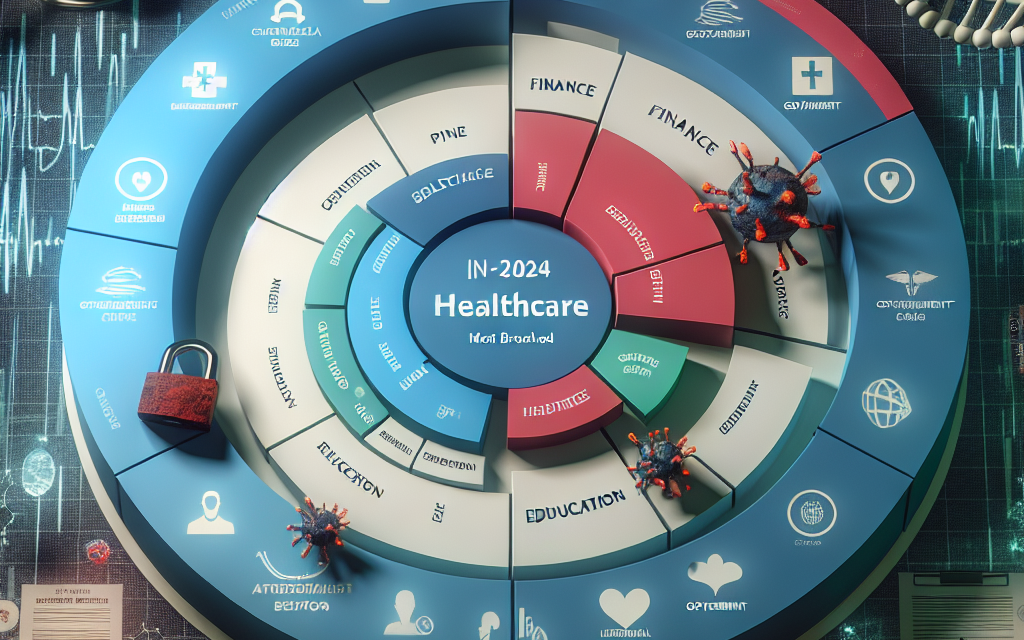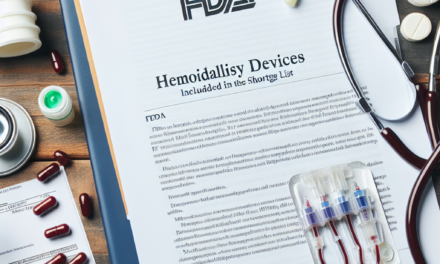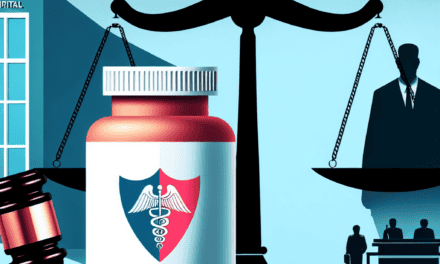2024 Report Reveals Healthcare as the Most Breached Sector
The healthcare sector has long been a target for cybercriminals, but the 2024 report has brought alarming statistics to light, confirming that healthcare is now the most breached sector. This article delves into the reasons behind this trend, the implications for patients and providers, and the measures that can be taken to mitigate these risks. With a focus on five key subtopics, we will explore the current landscape of healthcare breaches, the types of data at risk, the impact on patient care, case studies of significant breaches, and strategies for improving cybersecurity in healthcare.
The Current Landscape of Healthcare Breaches
In recent years, the healthcare industry has witnessed a surge in data breaches, with the 2024 report indicating a staggering increase in incidents. According to the report, healthcare organizations experienced a 30% rise in breaches compared to the previous year, affecting millions of patients and leading to significant financial losses.
Several factors contribute to this alarming trend:
- Increased Digitization: The shift towards electronic health records (EHRs) and telehealth services has expanded the attack surface for cybercriminals. With more data stored online, the potential for breaches has grown exponentially.
- Ransomware Attacks: Ransomware has become a prevalent threat in the healthcare sector. Attackers encrypt critical data and demand payment for its release, often targeting hospitals and clinics that cannot afford downtime.
- Insider Threats: Employees with access to sensitive data can pose a significant risk, whether through negligence or malicious intent. Insider threats have been responsible for a notable percentage of breaches in healthcare.
- Third-Party Vendors: Many healthcare organizations rely on third-party vendors for various services, which can introduce vulnerabilities. Breaches at these vendors can compromise the data of multiple healthcare providers.
- Regulatory Challenges: Compliance with regulations such as HIPAA can be complex, and failure to adhere to these standards can lead to data breaches and hefty fines.
As the landscape continues to evolve, healthcare organizations must remain vigilant and proactive in their cybersecurity efforts. The increasing frequency and sophistication of attacks necessitate a comprehensive approach to data protection.
Types of Data at Risk
Healthcare data is particularly valuable to cybercriminals due to its sensitive nature. The types of data at risk include:
- Personal Identifiable Information (PII): This includes names, addresses, Social Security numbers, and other identifying information that can be used for identity theft.
- Protected Health Information (PHI): PHI encompasses medical records, treatment histories, and billing information, which can be exploited for fraudulent activities.
- Financial Information: Payment details and insurance information are often targeted, as they can be used for financial gain.
- Research Data: Clinical trial data and proprietary research can be valuable to competitors and foreign entities.
- Operational Data: Information related to hospital operations, staffing, and supply chains can be used to disrupt services.
The value of healthcare data on the dark web is significant, with some estimates suggesting that medical records can sell for up to $1,000 each. This high value incentivizes cybercriminals to target healthcare organizations, leading to a vicious cycle of breaches and data theft.
The Impact on Patient Care
The ramifications of healthcare breaches extend beyond financial losses; they can significantly impact patient care. When a breach occurs, healthcare organizations may face several challenges:
- Disruption of Services: Breaches can lead to system outages, preventing healthcare providers from accessing critical patient information. This can delay treatment and compromise patient safety.
- Loss of Trust: Patients may lose confidence in their healthcare providers if they believe their data is not secure. This loss of trust can lead to decreased patient engagement and reluctance to share necessary information.
- Legal and Financial Consequences: Healthcare organizations may face lawsuits and regulatory fines following a breach, diverting resources away from patient care.
- Increased Costs: The financial burden of a breach can lead to higher healthcare costs for patients, as organizations may pass on the costs of remediation and compliance to consumers.
- Impact on Mental Health: Patients whose data has been compromised may experience anxiety and stress, further complicating their health conditions.
To mitigate these impacts, healthcare organizations must prioritize cybersecurity and develop robust incident response plans. By doing so, they can minimize disruptions and maintain the trust of their patients.
Case Studies of Significant Breaches
Several high-profile breaches in the healthcare sector have underscored the vulnerabilities present in the industry. These case studies provide valuable lessons for organizations looking to improve their cybersecurity posture.
1. Anthem Inc. (2015)
In 2015, Anthem Inc., one of the largest health insurers in the United States, suffered a massive data breach that exposed the personal information of approximately 78.8 million individuals. The breach was attributed to a sophisticated cyberattack that exploited vulnerabilities in the company’s systems.
The attackers gained access to sensitive data, including names, birth dates, Social Security numbers, and employment information. The breach resulted in significant financial losses for Anthem, as well as reputational damage. In response, the company implemented enhanced security measures and offered credit monitoring services to affected individuals.
2. Universal Health Services (UHS) (2020)
In September 2020, UHS, a major healthcare provider, experienced a ransomware attack that disrupted operations across its facilities. The attack forced UHS to revert to paper-based systems, leading to delays in patient care and significant operational challenges.
The breach affected the personal and medical information of millions of patients, prompting UHS to invest in cybersecurity improvements and employee training. The incident highlighted the critical need for healthcare organizations to prepare for ransomware attacks and develop comprehensive response plans.
3. Community Health Systems (CHS) (2014)
In 2014, CHS reported a data breach that compromised the personal information of 4.5 million patients. The breach was attributed to a cyberattack that exploited vulnerabilities in the company’s network.
The stolen data included names, birth dates, Social Security numbers, and addresses. Following the breach, CHS faced legal action and regulatory scrutiny, resulting in a settlement of $5 million. The incident underscored the importance of proactive cybersecurity measures and the need for ongoing employee training to recognize potential threats.
4. Premera Blue Cross (2015)
Premera Blue Cross experienced a data breach in 2015 that exposed the personal information of 11 million individuals. The breach was discovered during a routine security assessment and was attributed to a sophisticated cyberattack.
The compromised data included names, birth dates, Social Security numbers, and medical information. Premera faced significant legal and regulatory consequences, including a $10 million settlement. The incident prompted the company to enhance its cybersecurity measures and invest in employee training programs.
5. Scripps Health (2021)
In May 2021, Scripps Health experienced a ransomware attack that disrupted its operations and forced the organization to divert patients to other facilities. The attack compromised the personal and medical information of thousands of patients.
Scripps Health faced significant operational challenges as it worked to restore its systems and ensure patient safety. The incident highlighted the need for healthcare organizations to develop robust incident response plans and invest in cybersecurity training for employees.
Strategies for Improving Cybersecurity in Healthcare
To combat the rising threat of data breaches, healthcare organizations must adopt a multi-faceted approach to cybersecurity. Here are several strategies that can help improve data protection:
- Conduct Regular Risk Assessments: Organizations should perform regular risk assessments to identify vulnerabilities in their systems and develop strategies to mitigate these risks.
- Implement Strong Access Controls: Limiting access to sensitive data based on job roles can help reduce the risk of insider threats and unauthorized access.
- Invest in Employee Training: Regular training programs can help employees recognize phishing attempts and other cyber threats, fostering a culture of cybersecurity awareness.
- Utilize Encryption: Encrypting sensitive data both in transit and at rest can help protect it from unauthorized access, even in the event of a breach.
- Develop an Incident Response Plan: Having a well-defined incident response plan can help organizations respond quickly and effectively to breaches, minimizing their impact on patient care.
By implementing these strategies, healthcare organizations can enhance their cybersecurity posture and better protect sensitive patient data from breaches.
Conclusion
The 2024 report has made it clear that healthcare is the most breached sector, with significant implications for patients and providers alike. As cybercriminals continue to exploit vulnerabilities in the industry, healthcare organizations must prioritize cybersecurity and take proactive measures to protect sensitive data.
By understanding the current landscape of healthcare breaches, recognizing the types of data at risk, and learning from past incidents, organizations can develop effective strategies to mitigate risks. The impact of breaches on patient care cannot be overstated, making it essential for healthcare providers to foster a culture of cybersecurity awareness and preparedness.
In summary, the healthcare sector must remain vigilant in the face of evolving cyber threats. By investing in robust cybersecurity measures and fostering a culture of awareness, healthcare organizations can protect their patients and maintain trust in an increasingly digital world.





